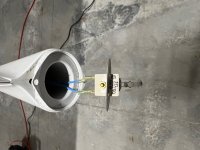Hello!
I'm in the process of upgrading all external lights on my RV9-A to LED. My current tail light is a TP20X connected as shown. I need to connect the wire for the position light and ground and leave the Sync and ACL wires alone. I don't think the polarity is marked on the bulb so just trial and error to determine the ground wire? I think I can just solder the connections since I don't have any slack to use any type of physical connector. I'm assuming heat shrink tubing and/or electrical tape will suffice?
Thanks!
Mike

I'm in the process of upgrading all external lights on my RV9-A to LED. My current tail light is a TP20X connected as shown. I need to connect the wire for the position light and ground and leave the Sync and ACL wires alone. I don't think the polarity is marked on the bulb so just trial and error to determine the ground wire? I think I can just solder the connections since I don't have any slack to use any type of physical connector. I'm assuming heat shrink tubing and/or electrical tape will suffice?
Thanks!
Mike





